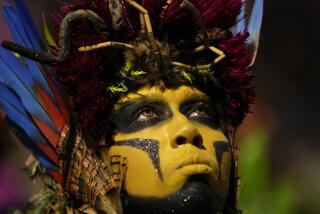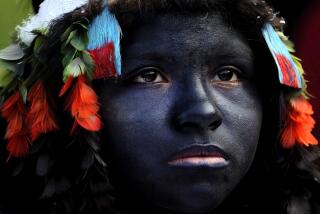Stone Age Tribe Leaps Into 21st Century
KOSHIROWATERI, Venezuela — When they were “discovered” several decades ago by anthropologists and missionaries, the Yanomami Indians were living much as they had for centuries. Even millenniums.
Today, some Yanomami villages of thatched huts, called “shabonos,” still are virtually out of reach of civilization, deep in jungle clearings in the trackless rain forest.
But many of the 23,000 Yanomamis have gravitated to missions and rural towns. There, the so-called Stone Age Indians, no longer naked and barefoot, trudge through the Amazon in Reeboks.
Take Koshirowateri, an isolated village of about 300 people also known as Mission Padamo. Tucked away in the jungle of southeastern Venezuela, it is reachable only by boat or plane, but the Yanomamis living here wear blue jeans, New York Mets baseball caps and plastic bead chains.
Through a mission interpreter, a 23-year-old Yanomami, Ruben Perez, described how recent flooding by the Orinoco River collapsed his mud hut and ruined his small food garden.
To ward off buzzing hordes of mosquitoes, he calmly pulled out a can of Off insect repellent and sprayed himself and his Chicago Bulls T-shirt. On the floor of his mud hut were a beat-up pair of in-line skates.
Such goods come from Protestant missionaries who arrived in 1960. Their A-frame houses and cemetery with white picket fence add to the sense of cultural disorientation in this damp, endless expanse of green trees and muddy water that is home to the Yanomami, or Yanomamo, depending on the transliteration.
In an updated preface to his 1968 book, “Yanomamo: The Last Days of Eden,” U.S. anthropologist Napoleon Chagnon wrote, “The Yanomamo are the last major primitive tribe left in the Amazon Basin, and the last such people anywhere on Earth.”
There are a lot fewer today so out of touch.
In a telephone interview from UC Santa Barbara, Chagnon said worldly intrusions--illegal gold miners, well-intentioned missionaries, government officials--are eroding tribal traditions at a stunning pace.
“When I began my work in the 1960s, probably 90% of the Yanomamo were relatively isolated. In 1996, probably only 10% of them are . . . and these pockets are shrinking by the day,” he said.
He said the Indians at Mission Padamo are among the most exposed to civilization.
At the other extreme, Yanomamis in remote villages still wear loincloths or go naked and pierce their noses and cheeks with sticks. Armed with clubs and bows and arrows, they raid other villages and fend off such raids as they have since time immemorial.
Now, as then, they thatch huts with reeds, make bread from roots like cassava, weave sleeping hammocks by hand, and hollow out canoes from logs.
On the whole, Ruben Perez thinks contact with “civilization” has improved life for the tribe.
“There’s a lot more peace,” he said in Yanomami. “Before, we used to live in fear of other villages coming and raiding us.”
He attributes the peace to “the word of God” that missionaries have brought to the jungle.
Not all is tranquillity. Fighting with clubs is still common among the Yanomamis, dubbed “The Fierce People” by Chagnon in his book. Indeed, missionary Gary Dawson, who arrived 36 years ago from Virginia, had to cut short an interview to stitch up one victim’s head.
A new weapon has escalated the violence: the shotgun. Many Yanomamis buy them in Puerto Ayacucho or towns in nearby Brazil.
“In the other villages, there is a lot of killing still,” Perez said. “It’s worse because now we have shotguns that are even more dangerous than our arrows. . . .
“Most of the older people still know the traditions and the culture, but the younger generation . . . don’t even bother to find them out,” he said.
What are some cherished traditions? “I don’t even know,” Perez said.
More to Read
Sign up for Essential California
The most important California stories and recommendations in your inbox every morning.
You may occasionally receive promotional content from the Los Angeles Times.










